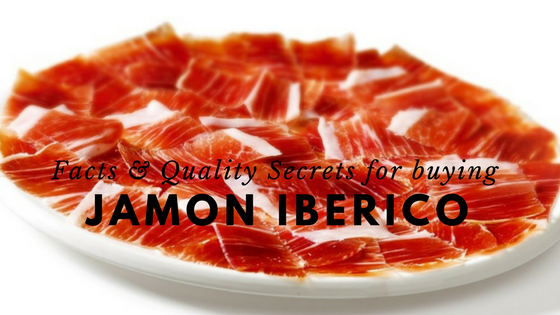FACTS & QUALITY SECRETS FOR BUYING JAMON IBERICO

The Spanish tradition of producing Jamon Iberico traces back more than two thousand years when the Romans controlled most of Spain. But until the 13th century Jamon was exclusively served to the royalty. Nowadays, Spaniards eat on average up to 7 pounds of cured ham per year. Due to the importance of this delicacy in the world of spanish culinary, we would like to share with you some basic facts and secrets on buying and recognising a good jamon iberico.
The five official types of jamón
The following types of Jamón tell us already a lot about the quality of the meat, beacause the type is related to the different kinds of pigs. Where it came from and what the animal was eating during it´s lifetime are two of the main parameters.
1. JAMÓN IBÉRICO – comes from Iberian pigs and they live and eat normally mostly indoors.
2. JAMÓN SERRANO – comes from the white pigs and also stay normally al their life indoors.
3. JAMÓN IBÉRICO DE RECEBO – is made from Iberian pigs that are fed on acorns and pasture grasses. Mostly they live indoor.
4. JAMÓN IBÉRICO DE BELLOTA – is made from Iberian pigs that are fed acorns. The pigs are raised outdoor and free eating all day long their acorns.
5. JAMÓN IBÉRICO DE CEBO O CAMPO – describes jamón made from pigs that have the fortune to graize freely in the fields and enjoy natural feeding.
What you need to know for buying Jamon Iberico
There is a relatively new system that makes jamon iberico product labels much simpler, so you know exactly what you’re buying – what the animal was fed on as well as its breeding.
The labelling takes into account three main factors:
1. The breed of the pig: Some pigs will be 100% Iberian, with both parents pure-bred. Others will be part Iberian mixed with another breed. But now the percentage of Iberian must be specified so its exact genealogy can be traced.
2. The pig’s diet: bellota (acorns), cebo del campo (natural grazing) or cebo (fodder).
3. The way and quality of raising: allowed to roam free (eating acorns or grazing naturally), or kept enclosed in a pen (and fed fodder).
The Colour Coded Quality Labels
BLACK LABEL – Jamon 100% Iberico de Bellota. This is the top category – the finest available – and indicates a pure-bred Iberian pig which has been fed only on acorns during the montanero period (October to February).
RED LABEL – Jamon Iberico de Bellota, where the pig is partly Iberian – the percentage of Iberian breed must be specified. The pig has been allowed to roam free, eating acorns.
GREEN LABEL – Jamon Iberico de Cebo de Campo. This pig is at least 50% Iberian, and has been allowed to roam freely, eating both natural grazing and fodder.
WHITE LABEL – Jamon Iberico de Cebo. This pig is at least 50% Iberian, and has been kept enclosed in a pen and given fodder.
The labelling is intruduced gradually, therefore all newly produced Iberian hams will have to bear the colour-coded labels, but those products already on sale will not. So until all existing ham products are sold, some will remain that aren’t coded as per the new system.
Two more Quality Facts & Secrets
First Secret – ACORNS: The acids in acorns cause the meat to become extremely tender, and imagine that an Iberian pig can eat up to 8 Kilos of acorns a day!
Second Secret – TIME: Another aspect which will be controlled now more often is the length of time ham is cured for. Curing these giant ham legs takes often years of time and some of the best hams are cured 5 years or more!
